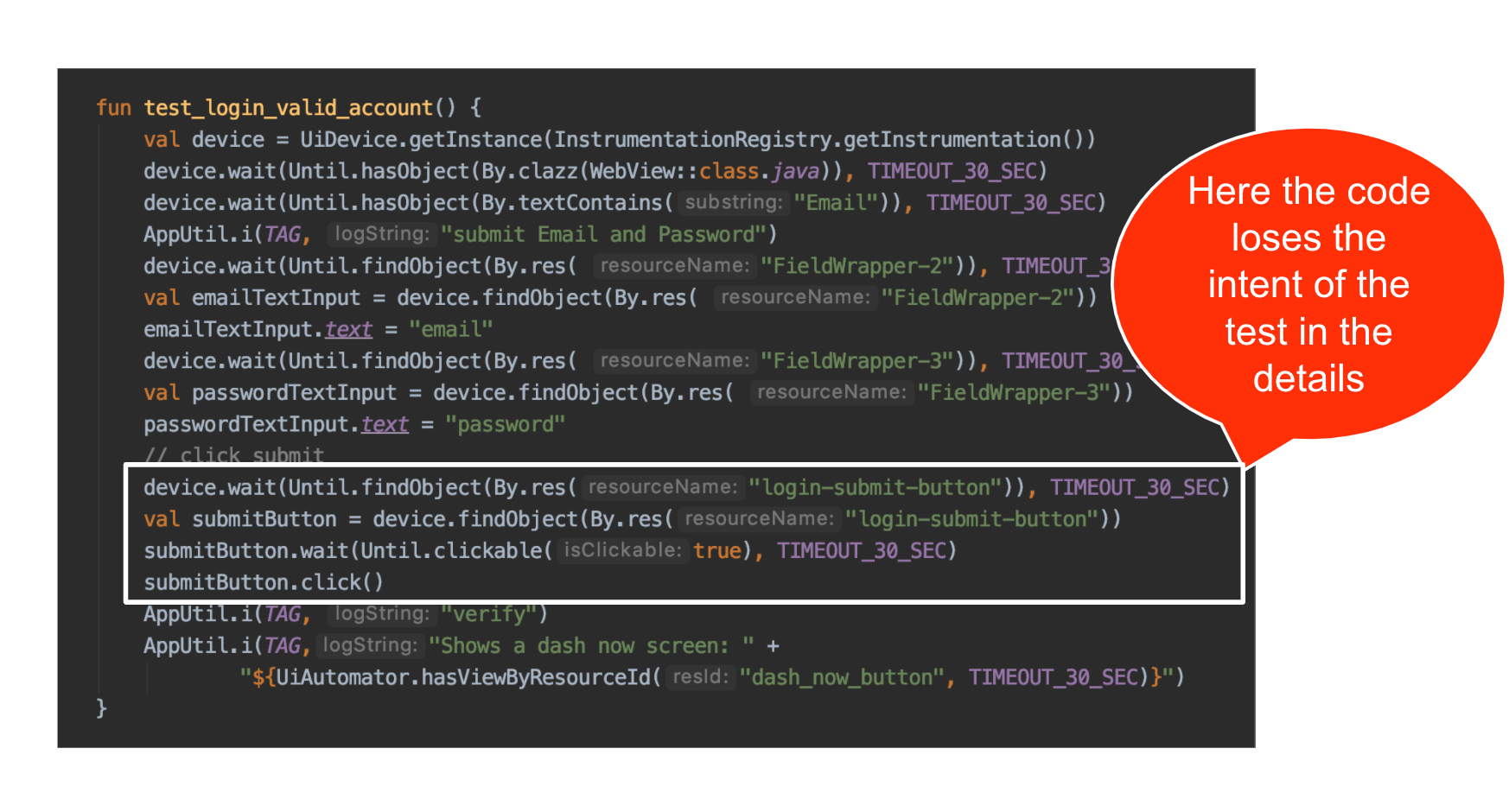The challenges of UI testing
Fast, scalable UI testing is a key challenge in ensuring mobile app development is bug-free, because test automation tools do not produce easy to read, scalable tests and alternatives are equally time consuming. While tools like UI Automator or Espresso using Android Studio have made it easier for engineers to start writing tests on Android to simulate user behavior, on their own the tests are difficult to understand and manage at scale. While testing may be fine at the start, increasing the number of tests makes it more difficult to understand the test code, causing a maintenance problem in the long run. Test automation tools can produce test code where each action is described in three to four lines of instructions, rather than having concise lines with clear descriptors, using business language, as shown in Figure 1, below:
How a design pattern can help with UI automation
The issues with manual UI tests can be addressed by choosing a good design pattern and the right framework for UI testing. A good automation test framework should allow engineers to write tests that are:- Easy to understand and read
- Quickly written
- Maintainable
- Scalable

- Each action can be performed in one line
- Details are extracted within a function
- This function can be reused whenever this action is required again
- The test is still not clearly showing it’s intent; instead it looks more like coded instructions
- There will still be a lot of code duplication, which is not ideal
Using a Fluent Interface to highlight the business logic
A Fluent design pattern provides us with the best of both worlds, as it demonstrates clear intent by using domain-specific language. A Fluent Interface is an object-oriented API whose design relies extensively on method chaining. The goal is to increase code readability by using domain-specific language, allowing the relay of the instruction context of a subsequent call.How a Fluent design pattern demonstrates clear intent
Design patterns should have clear intent and should use a domain-specific language that can almost be read like conversational language. A Fluent Interface fits the bill because it allows us to use API names that flow and domain-specific language. The benefits of using a Fluent design pattern include:- When test code is easy to understand, it is easy to extend and reuse
- The ease of use will help developers work more quickly and be more confident when writing tests
- The design pattern is agnostic to underlying tools like UI Automator or Espresso
Utilizing a Fluent design pattern to build the Dasher app UI test automation
Here at Doordash, we had been using TestRail for manually testing the app before every release. It used to take three software engineers and one quality assurance engineer to go through the TestRail tests and half a day each to run the tests, taking two full work days. This process limited our app releases to every two weeks. Establishing a new UI automation framework for Android eliminated these pain points for release cycles. We will now go into a bit more detail to explain the approach and tooling we used, the overall high level solution architecture, and share some best practices.Our approach to utilizing Fluent design patterns
Generally, every UI test scenario involves interactions with activities and screens; on each screen the user will take some action and expect some behavior as a result. We then use assertions to verify the results. To conduct these tests, we structure the test code in such a way that each screen encapsulates the actions that are performed on that screen and can verify the behavior after performing those actions. All interactions are named in domain-specific language using the Fluent design pattern interface, as shown in Figure 3, below:
Testing suite
Tooling choice plays a big role in improving developer productivity. We find that our tooling proves easy to work with and has good online support. UI testing tools: Before developing our UI test procedures, we considered different tools for writing UI tests, such as Appium, a third-party tool. However, we found that Android’s native tools were easier to use and had better support. There are two UI testing tools supported by Google, which can be run separately or together, since they run under the same instrumentation test runner:- UI Automator - UI Automator is a UI testing framework suitable for cross-app functional UI testing across system and installed apps.
- Espresso - A key benefit of using Espresso is that it provides automatic synchronization of test actions with the UI of the app being tested. Espresso detects when the main thread is idle, so it is able to run test commands at the appropriate time, improving the reliability of the tests.
- Android Studio: For developers who believe that UI testing is an integral part of app development, Android Studio will make their lives easier. It allows running the unit tests, Android UI tests, and the app itself from the same development environment. It also allows the package structure such that the app code and its corresponding tests (unit tests and UI tests) can reside in the same repository, making it easy to maintain app code versions and their corresponding tests.
- UI tests are generally run on either a real device or an emulator to imitate the test scenario. For most of our test cases, we use emulators for common device configurations and sizes.
- Bitrise is one of the most popular CI/CD tools on the cloud that allows scaling and ease of use for setting up test environments. Especially for UI testing it allows integration for both a device farm and virtual devices and has become an easy tool to set up a build and testing environment for developers.
Testing process
We write test scenarios, shown in Figure 3, above, in a domain-specific language following a behavior-driven approach. These tests use the test setup API to create the environment for a particular test and use screen objects that interact with the screens and verify actions. Screen interaction and verification are ultimately performed through a test automation tool, such as UI Automator, Espresso, or any other similar tool. To understand this process, let’s look at an example for the login flow of an app using a Fluent design pattern and our testing architecture described above. Login test:


Reviewing the folder structure
For clean coders and software crafters, the primary property of a package is the possibility to have a meaningful name that describes its purpose and its reason for existence. Therefore, we have organized our packages as follows:- test: Holds all the tests for various scenarios
- screen: Holds all the screens within the app and the corresponding interactions
- UI Automator/Espresso: Holds tool classes for performing screen interactions and verifying behaviors
- utils: Common API to setup environment for a test execution, e.g. creating and assigning orders before Dashing starts. It also holds other common utility functions.

Best practices for using this approach
While writing these tests we developed a few best practices that helped us keep our code clean, readable, and extensible. Here are a few that we follow:- Naming convention: Even for the UIAutomator class we continue using the Fluent design pattern, which reads like a domain specific language.
- UiAutomator.kt: This class will essentially have two kinds of functions, any action that the user takes on the screen and verification of the behavior.
- Verification function name uses this pattern: hasViewBy<Class,Text,ContenDesc,ResourceId etc that identifies the view>
- Action function name has this pattern: <click,swipe,scroll,set><Button/View>By<Button/View identifies>
- Screen: It is very important to use the Fluent design pattern here, and figure out the correct naming of the functions that flow well while reading the test.
- Name of the screen class is as per what that screen does, eg. PickUpItemScreen()
- Verification function name is in domain specific language, eg. verifyAmount(), verifySignatureStepComplete(), verifyCompleteStepsGetCxSignature() etc
- Action function name is also in domain specific language, eg. clickStartCateringSetup(), slideBeforeCateringSetupComplete() etc
- UiAutomator.kt: This class will essentially have two kinds of functions, any action that the user takes on the screen and verification of the behavior.
- We should always add a log within each function of the screen class, which helps in troubleshooting faster on CI/CD logs.
- Any dialog/bottom sheet that is relevant to a screen is defined as a nested class of the parent screen.
- All the verifications should have been asserted with a log message that clearly states the reason for the failure of the assertion, as shown in Figure 8, below:

Fluent design pattern increases developer velocity
Once the initial framework was set up, we finished 70% of our regression tests in two months. Here are some of the results:- Our code coverage moved from 0% to ~40%.
- Our manual testing got four times faster, going from 16 hours to four hours.
- Release cycles have gone from one every two weeks to weekly releases, and we can run regression tests any time we want.
- The team is more productive because we only need to write the tests for new features or update the existing ones, which is much faster to develop.

